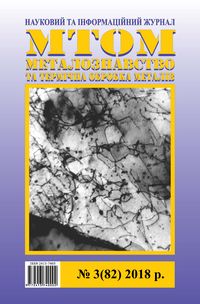Estimation of corrosion stability of chemically deposited coatings on the basis of copper and tin for protection of welding wire
DOI:
https://doi.org/10.30838/J.PMHTM.2413.250918.47.398Keywords:
welding wire, chemical deposition, copper tinning, corrosion resistance, electrochemical corrosionAbstract
Abstract. Purpose. Provides high corrosion resistance while maintaining the required operational and functional properties of the welding wire by applying chemically deposited metal coatings. Methodology. The corrosion resistance ofvarious types of metallic coatings deposited by the method of contact chemical deposition on a steel welding wire of the mark Sv-08G2S was studied: a copper covering with a thickness of 0.6 microns, two types of tin coatings, differing in thickness (0.3 and 0.6 microns), and a complex tin-copper thickness of 0.8 microns. Purpose of the data of coatings -increase the electrical conductivity of the welding wire and their protection against corrosion. Corrosive tests were carried out in salt fog, with high humidity and temperature, as well as in natural atmospheric conditions. As indicators for assessing the corrosion resistance of coatings, the mass index of corrosion and the degree of corrosive damage to the surface were used. Optical microscopy was used to assess the degree of corrosion damage. Findings. The most corrosion resistance among all the coatings covered is copper coating. This is due, firstly, to its rather large thickness, and secondly to the nature of the behavior of galvanic pair copper-iron under conditions of influence of environments leading to electrochemical corrosion. Sufficiently high corrosion resistance of complex copper-tin coatings can be explained only by a large thickness and a satisfactory density and integrity. However, their protective ability is much lower than that of pure copper coatings. Anticorrosion properties of tin coatings are very low. Some increase in the protective ability of the lusted wire is observed only in the case of a significant increase in the thickness of the coating, which should ensure its continuity. At low values of the thickness of the coating of tin, its corrosion resistance is lower than that of a wire without coating. Thus, the most effective coating of welding wire, which provides not only its corrosion resistance, but also increased electrical conductivity, is a copper coating, thickness 0,5...1 microns. Originality. For the first time the laws of behavior of chemically deposited coatings based on copper and tin on the surface of welding wire in various corrosive environments have been determined. Practical value. The practical value of the results obtained is that the most effective types of metal coatings deposited by the chemical precipitation method from solutions to protect the welding wire from corrosion have been identified. Anticorrosion protection with the use of such types of coatings allows not only to increase the storage and transportation time of the welding wire but to improve its functional and performance characteristics.
References
Kudryavtsev М.Т. `Elektroliticheskie pokrytiya metallami[Electrolytic metal coatings]. Moscow : Metallurgy, 1979, 351 p. (in Russian).
Vyacheslavov P.M. Metallicheskie pokrytiya, nanesennye himicheskim sposobom[Metal coatings applied by chemical means]. Leningrad : Engineering, 1985, 103 p. (in Russian).
Astalyuhina A.S. and Pikalov E.S. Harakteristika sovremennyh metodov naneseniya zacshitnyh tsynkovyh pokrytiy[Characteristics of modern methods of applying protective zinc coatings]. Uspehi sovremennogo prirodovedeniya. [Successes of modern natural history]. 2015, no. 11–1, p.p. 11–14. (in Russian).
Ulig G.G. and Revi R.U. Korroziya i bor'ba s nej. Vvedenie v korrozionnuyu nauku i tehniku[Corrosion and fight with it. Introduction to Corrosion Science and Technology]. Leningrad : Chemistry, 1989, 456 p. (in Russian).
Shluger M.A., Azhogin F.F. and Yefimov E.A. Korroziya i zaschita metallov[Corrosion and protection of metals]. Moscow : Metallurgy, 1981, 216 p. (in Russian).
Gerasimenko A.A. Zaschita ot korrozii, stareniya i biopovrezhdenij mashin, oborudovaniya i sooruzhenij. Spravochnik v 2-h tomah[Protection against corrosion, aging and biodeterioration of machinery, equipment and structures. Handbook in 2 volumes]. Moscow : Engineering, 1987, 700 p. (in Russian).
Ketov V.M., Vnukov A.A., Demchenko E.I.and Roslik I.G. Issledovanie vliyaniya sposoba legirovaniya medyu na svoystva poroshkovyh shiht i harakteristiki spechennyh materialov na osnove zheleza[Study of the copper alloying methods influence on the properties of powder blends and sintered iron-based materials characteristics]. Sbornik dokladov Mezhdunarodnogo simpoziuma Inzheneriya poverhnosti. Novyye poroshkovyye kompozitsionnyye materialy. Svarka. [Collection of reports of the International Symposium Surface Engineering. New powder composite materials. Welding]. 2011, Minsk, 23–25 of March, pp. 153–157. (in Russian).
Vnukov A.A. Struktura i svojstva spechennyh materialov na osnove sistemy Fe−Cu−C, poluchennyh s primeneniem razlichnyh sposobov legirovaniya [Structure and properties of sintered materials based on the system Fe−Cu−C, obtained using various methods of alloying]. Vistnik NTU «HPI» [Herald of STU «KhPI»]. 2015, no.49, p.p. 3–6.(in Russian).
GOST 9.308-85 Pokrytiya metallicheskie i nemetallicheskie neorganicheskie. Metody uskorennyh ispytanij[Metallic and nonmetallic inorganic coatings. Accelerated test methods]. Moscow : Standards publishing house, 1985, 11 p. (in Russian).
Fokin M.N. and Zhigalova K.A. Metody korrozionnyh ispytanij metallov[Methods of metals corrosion testing]. Moscow : Metallurgy, 1986, 80 p. (in Russian).
Downloads
Published
Issue
Section
License
Authors that are published in this journal agree to follow the conditions:
Authors reserve the right to the authorship of his work and cede the right to the journal of first publication of this work on conditions of the license under the Creative Commons Attribution License, which allows others to distribute it freely with the obligatory reference to the author of the original work and the first publication of the work in this journal.

